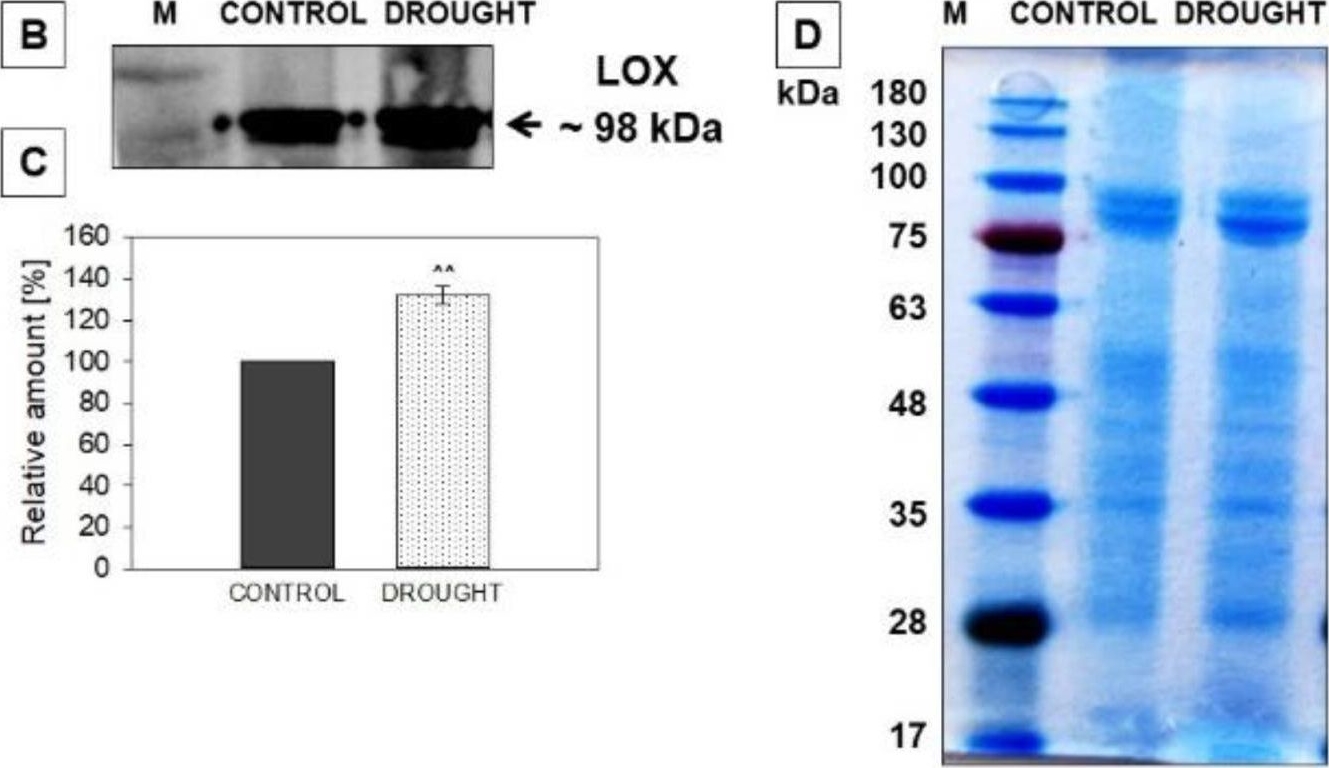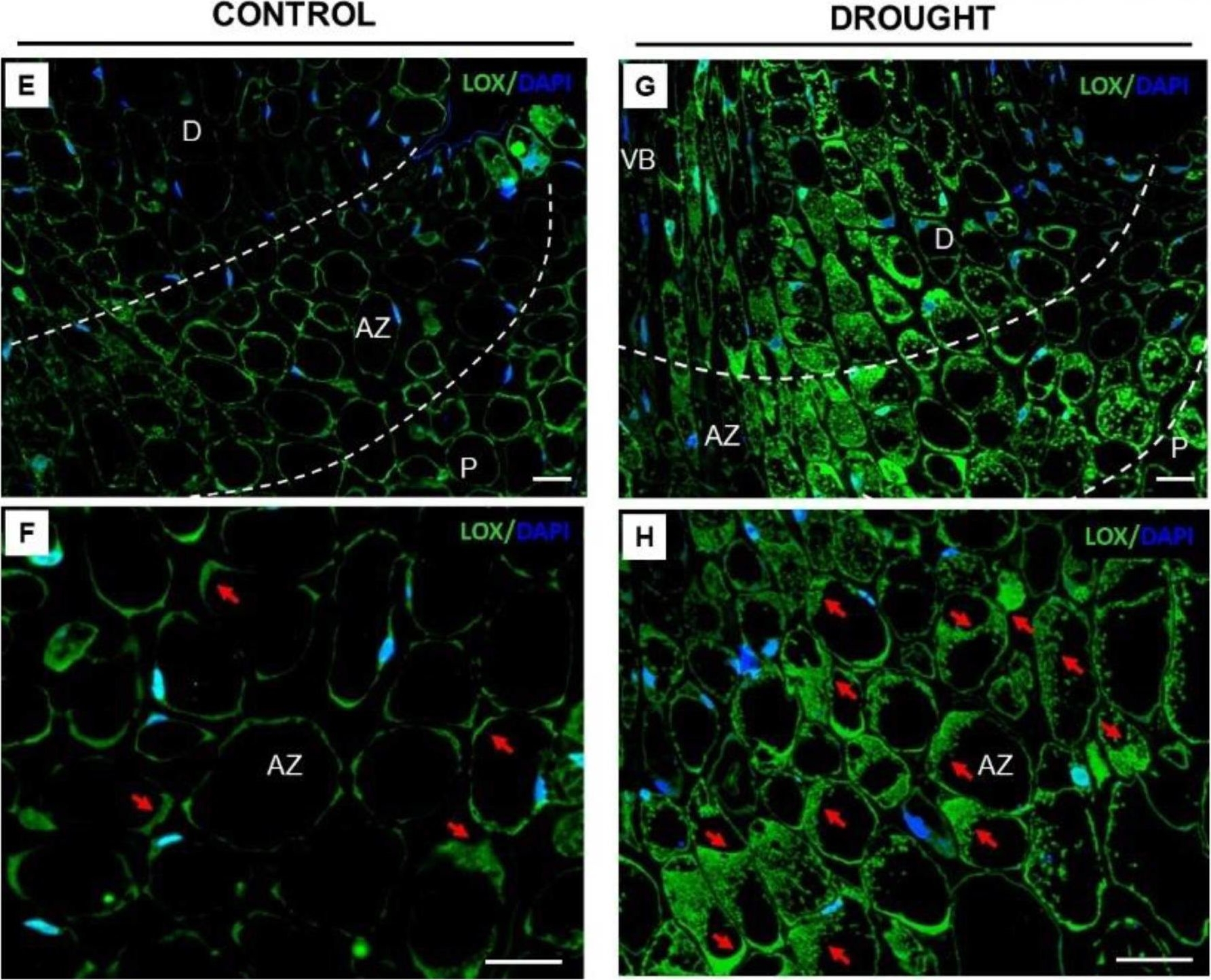1

Anti-LOX | Lipoxygenase
AS06 128 | Clonality: Polyclonal | Host: Rabbit | Reactivity: A.thaliana, G. max, L. longiflorum, L. luteus, O. europaea, O. sativa
- Product Info
-
Immunogen: Native lipoxygenase, type I-B, purified from Glycine max (Sigma, product number L7395) UniProt: P08170
Host: Rabbit Clonality: Polyclonal Purity: Serum Format: Lyophilized Quantity: 50 µl Reconstitution: For reconstitution add 50 µl of sterile water Storage: Store lyophilized/reconstituted at -20°C; once reconstituted make aliquots to avoid repeated freeze-thaw cycles. Please remember to spin the tubes briefly prior to opening them to avoid any losses that might occur from material adhering to the cap or sides of the tube. Tested applications: Immunofluorescence (IF), Western blot (WB) Recommended dilution: 1: 50 (IF), 1 : 1000 (WB) Expected | apparent MW: 54 (subunit), 108 (native enzyme)
- Reactivity
-
Confirmed reactivity: Arabidopsis thaliana, Glycine max, Lilium longiflorum, Lupinus luteus, Musa acuminate, Musa paradisiaca L., Nicotiana benthamiana, Olea europaea, Oryza sativa
Predicted reactivity: Glycine max, Lathyrus undulatus, Malus x domestica, Solanum tuberosum, Vicia faba
Species of your interest not listed? Contact usNot reactive in: Chlamydomonas reinhardtii
- Application Examples
-
Application example 
Samples of Arabidopsis thaliana (2), Olea europaea (3), Lilium Longiflorum (4), Lupinus luteus (5) were ground in liquid nitrogen to a very fine powder using a mortar and pestle and resuspended in 1.5 ml of extraction buffer (4% SDS, 2% 2-mercaptoethanol, 2 mM PMSF, 100 mM Tris-HCl pH 8.5). The samples were incubated for 3 min at 80°C. Protein suspensions were clarified by centrifugation at 13,500 g for 10 min at room temperature and the resulting supernatants were used. Total proteins (25 µg per sample) were separated by SDS-PAGE on CriterionTMTGXTM Precast Gel (Bio-Rad, USA) using CriterionTM Cell apparatus (Bio-Rad). Proteins were electroblotted onto a PVDF membrane using Trans-Blot® TurboTM Transfer Pack (Bio-Rad) in a Trans-Blot® TurboTM Transfer System (Bio-Rad). The membrane was blocked for 1 h in solution containing 1 % (w/v) non-fat dry milk in TRIS-buffered saline (TBS) buffer, pH 7.4. The membrane was incubated in the primary antibody at a dilution of 1: 1000 in TBS buffer containing 1 % (w/v) non-fat dry milk over night at 4°C with agitation. A DyLight 488 conjugated anti-rabbit IgG (AS10 831, Agrisera), diluted 1:2000 in TBS buffer for 2 h, served as the secondary antibody. The signal was detected in a Pharos FX molecular imager (Bio-Rad). Line 1 contains LOX protein from Sigma.
Courtesy of Dr. Agnieszka Zienkiewicz, CSIC, SpainApplication examples: 
Reactant: Lupinus luteus (European yellow lupine)
Application: Western Blotting
Pudmed ID: 35214860
Journal: Plants (Basel)
Figure Number: 3B,D
Published Date: 2022-02-15
First Author: Domagalski, K.
Impact Factor:
Open PublicationLipoxygenase (LOX) is regulated by drought in the flower abscission zone (AZ) of Lupinus luteus. Analyses were carried out on flower AZs collected from 48 day-old lupines cultivated under drought (25% water holding capacity, WHC) or control (70% WHC) conditions. See Material and Methods for the details. Plant tissues were used for the expression analysis of LlLOX2 (A). Asterix indicates a significant difference with * p < 0.05. The isoform of LOX of ~98 kDa was obtained on the nitrocellulose membrane in the Western blot reaction with an anti-LOX antibody (B). A band was scanned and quantitative densitometric analysis was made (C, 100% was set for the control). ^^p < 0.01 indicates a significant difference. SDS-PAGE electrophoresis gel stained with Coomassie Brilliant Blue (D). Sizes of molecular mass marker (M) are shown in kDa. Immunodetection of LOX in the flower’ AZ of control (E,F) and drought-stressed (G,H) plants. Green fluorescence indicates LOX accumulation (marked by red arrows), while blue labeling corresponds to nuclei stained with DAPI. AZ area is marked by white dotted lines. Images F and H are magnified regions of AZ from control and stressed tissues. Abbreviations: AZ—abscission zone; D—distal region of AZ; P—proximal region of AZ; VB—vascular bundle. Bars = 40 µM.

Reactant: Lupinus luteus (European yellow lupine)
Application: Immunocytochemistry
Pudmed ID: 35214860
Journal: Plants (Basel)
Figure Number: 3E,F,G,H
Published Date: 2022-02-15
First Author: Domagalski, K.
Impact Factor:
Open PublicationLipoxygenase (LOX) is regulated by drought in the flower abscission zone (AZ) of Lupinus luteus. Analyses were carried out on flower AZs collected from 48 day-old lupines cultivated under drought (25% water holding capacity, WHC) or control (70% WHC) conditions. See Material and Methods for the details. Plant tissues were used for the expression analysis of LlLOX2 (A). Asterix indicates a significant difference with * p < 0.05. The isoform of LOX of ~98 kDa was obtained on the nitrocellulose membrane in the Western blot reaction with an anti-LOX antibody (B). A band was scanned and quantitative densitometric analysis was made (C, 100% was set for the control). ^^p < 0.01 indicates a significant difference. SDS-PAGE electrophoresis gel stained with Coomassie Brilliant Blue (D). Sizes of molecular mass marker (M) are shown in kDa. Immunodetection of LOX in the flower’ AZ of control (E,F) and drought-stressed (G,H) plants. Green fluorescence indicates LOX accumulation (marked by red arrows), while blue labeling corresponds to nuclei stained with DAPI. AZ area is marked by white dotted lines. Images F and H are magnified regions of AZ from control and stressed tissues. Abbreviations: AZ—abscission zone; D—distal region of AZ; P—proximal region of AZ; VB—vascular bundle. Bars = 40 µM.
- Background
-
Background: Lipoxygenases (LOXs; EC 1.13.11.12, synonym: lipoxydases) are a family of enzymes that catalyze oxygenation of polyunsaturated fatty acids (PUFAs) into lipidhydroperoxides (LOOHs) involved in responses to stresses. LOXs has been found to play a role in plant growth and development, senescence as well as can be activated in response to environamental stress (drought, heavy metals). Synonymes: linoleate, oxygen oxidoreductase.
- Product Citations
-
Selected references: Burchardt et al. (2024). Exploring the response of yellow lupine (Lupinus luteus L.) root to drought mediated by pathways related to phytohormones, lipid, and redox homeostasis. BMC Plant Biol . 2024 Nov 6;24(1):1049. doi: 10.1186/s12870-024-05748-4. (Immunofluorescence)
Kucko et al. (2022) The acceleration of yellow lupine flower abscission by jasmonates is accompanied by lipid-related events in abscission zone cells, Plant Science, Volume 316, 2022,111173, ISSN 0168-9452, https://doi.org/10.1016/j.plantsci.2021.111173. (https://www.sciencedirect.com/science/article/pii/S0168945221003691)
Zhu et al. (2021) Physiological and Proteomic Analyses Reveal Effects of Putrescine-Alleviated Aluminum Toxicity in Rice Roots[J]. RICE SCI, 0, (): 3-.
Castro et al. (2020). Identification of seed storage proteins as the major constituents of the extra virgin olive oil proteome. Food Chem X . 2020 Jun 27;7:100099.doi: 10.1016/j.fochx.2020.100099.
Yang et al. (2012). Quantitative proteomic analysis reveals that antioxidation mechanisms contribute to cold tolerance in plantain (Musa paradisiaca L.; ABB Group) seedlings. Mol Cell Proteomics. 2012 Dec;11(12):1853-69. doi: 10.1074/mcp.M112.022079.
Huang et al. (2011). Cloning and characterization of a 9-lipoxygenase gene induced by pathogen attack from Nicotiana benthamiana for biotechnological application. BMC Biotechnol. 2011 Mar 30;11:30. doi: 10.1186/1472-6750-11-30.
Huang et al. (2010). Overexpression of hydroperoxide lyase gene in Nicotiana benthamiana using a viral vector system. Plant Biotechnol J. 2010 Sep;8(7):783-95. doi: 10.1111/j.1467-7652.2010.00508.x. - Protocols
-
Agrisera Western Blot protocol and video tutorials
Protocols to work with plant and algal protein extracts - Reviews:
-
| 2013-05-02The antibody recognizes also LOX in olive pollen (ref. Zienkiewicz et al. (2013) J. Exp Bot 64: 293-302.AGNIESZKA ZIENKIEWICZ | 2013-05-02I have used this antibody to localize LOX enzyme in situ in clotyledons of Olea europaea and for Western-blotting experiments. It works very well using both, immunofluorescence and immunogold techniques. The antibody specifically recognizes LOX in olive (conformed by immunoprecipitiation techniques).



